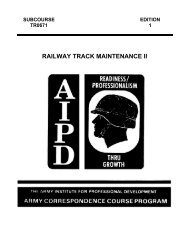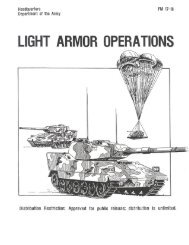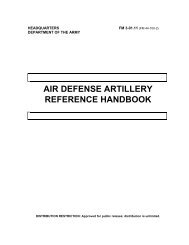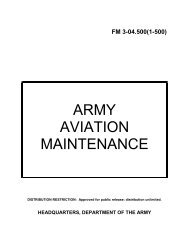fm 44-100 us army air and missile defense operations
fm 44-100 us army air and missile defense operations
fm 44-100 us army air and missile defense operations
You also want an ePaper? Increase the reach of your titles
YUMPU automatically turns print PDFs into web optimized ePapers that Google loves.
FM <strong>44</strong>-<strong>100</strong><br />
EVENT TEMPLATE<br />
A-35. An event template is a guide for collection <strong>and</strong> reconnaissance <strong>and</strong><br />
surveillance (R&S) planning. It depicts named areas of interest (NAI) where<br />
the comm<strong>and</strong>er expects to see certain activities of tactical significance <strong>and</strong> is<br />
<strong>us</strong>ed to confirm or deny an enemy course of action. These NAI are based on<br />
the terrain constraints on <strong>air</strong> approach routes to potential targets <strong>and</strong><br />
analysis of the enemy’s attack <strong>and</strong> ISR profiles. The G2 or S2 develops an<br />
event matrix to support the event template by providing details on the type of<br />
activity expected in each NAI, the times the NAI is expected to be active, <strong>and</strong><br />
its relationship to other events on the battlefield. Examples of NAI include<br />
l<strong>and</strong>ing <strong>and</strong> drop zones, forward arming <strong>and</strong> refueling points, forward<br />
staging areas, <strong>and</strong> previo<strong>us</strong> BM launch locations. See FM 34-130 for detailed<br />
information on preparing an event template <strong>and</strong> matrix.<br />
DECISION SUPPORT TEMPLATE<br />
A-36. A decision support template is based on the situation <strong>and</strong> event<br />
templates, event matrix, <strong>and</strong> the war gaming of friendly COA results. A<br />
decision support template should depict the following:<br />
• Air avenues of approach.<br />
• Airborne <strong>and</strong> <strong>air</strong> assault objectives.<br />
• L<strong>and</strong>ing <strong>and</strong> drop zones <strong>and</strong> largest size enemy element that could be<br />
employed at the zone.<br />
• Ranges of threat systems.<br />
• Ranges of friendly <strong>air</strong> <strong>and</strong> <strong>missile</strong> <strong>defense</strong> systems.<br />
• Target areas of interest (TAI).<br />
• Decision points (DP).<br />
A-37. Air TAI <strong>and</strong> DP are determined in the same manner as for ground<br />
<strong>operations</strong>. However, due to the high speeds of <strong>air</strong> systems, decision points<br />
m<strong>us</strong>t be placed significantly farther in advance of the TAI.<br />
APPLYING IPB<br />
A-38. IPB is a systematic, continuo<strong>us</strong> process of analyzing the threat <strong>and</strong><br />
environment in a specific geographic setting. Applying the IPB process helps<br />
the comm<strong>and</strong>er apply <strong>and</strong> maximize his combat power at critical points in<br />
time <strong>and</strong> space by determining the enemy's likely COA, <strong>and</strong> describing the<br />
environment <strong>and</strong> its effects on <strong>operations</strong>. Preparation <strong>and</strong> continuo<strong>us</strong><br />
updates of the aerial portion of IPB are fundamental to the execution of the<br />
<strong>air</strong> <strong>and</strong> <strong>missile</strong> <strong>defense</strong> <strong>and</strong> l<strong>and</strong> force missions on the modern battlefield.<br />
A-10











